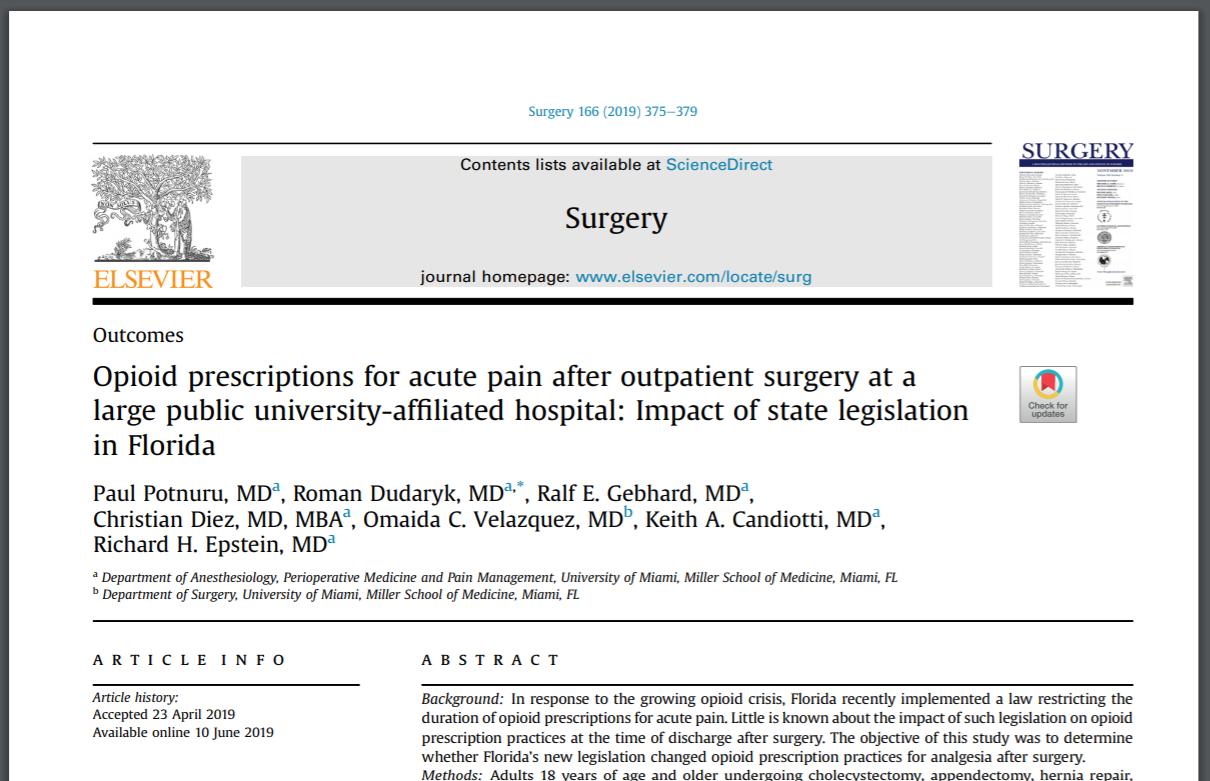Citation: Potnuru P, Dudaryk R, Gebhard RE, et al. Opioid prescriptions for acute pain after outpatient surgery at a large public university-affiliated hospital: Impact of state legislation in Florida. Surgery. 2019;166(3):375–379. PubMed ID: 31196705
Background: In response to the growing opioid crisis, Florida recently implemented a law restricting the duration of opioid prescriptions for acute pain. Little is known about the impact of such legislation on opioid prescription practices at the time of discharge after surgery. The objective of this study was to determine whether Florida’s new legislation changed opioid prescription practices for analgesia after surgery.
Methods: Adults 18 years of age and older undergoing cholecystectomy, appendectomy, hernia repair, hysterectomy, mastectomy, or lymph node dissection were included in this retrospective cohort study at a large public university-affiliated hospital. We analyzed opioid prescriptions on discharge after these common outpatient surgical procedures between June 1, 2017, and December 31, 2018. Florida House Bill 21 was passed on March 2, 2018, and subsequent implementation of this law took place on July 1, 2018. The law restricts the duration of opioid prescriptions for acute pain to 3 days, which can be extended up to a maximum of 7 days with additional documentation. The outcomes studied included the following: the proportion of patients receiving opioid prescriptions on discharge, total opioid dose prescribed, daily opioid dose prescribed, and the proportion of patients receiving more than a 3-day supply of opioids. We colledted data on emergency department cumulative visits within 7 and 30 days after discharge. Drug doses were converted to morphine milligram equivalents and calculated for each selected procedure.
Results: A total of 1,467 surgical encounters were included. The cohort was predominantly female (963 [65.6%]) with a mean (SD) age of 49.6 (14.4) years. At 6 months after implementation of HB 21, the proportion of patients receiving opioid prescriptions decreased by 21% (95% CI 16.8% to 25.3%, P < .001), mean total opioid dose prescribed decreased by 64.2 morphine milligram equivalents (95% CI 54.7 to 73.7, P < .001) from a baseline mean (SD) of 172.5 (78.9) morphine milligram equivalents. The mean daily opioid dose prescribed increased by 3.5 morphine milligram equivalents (95% CI 1.8 to 5.1, P < .001) from a baseline mean (SD) of 30.5 (9.4) morphine milligram equivalents. The proportion of patients receiving opioid prescriptions for longer than a 3-day supply decreased by 68% (95% CI 63.4% to 72.7%, P < .001). We observed no change in the number of postoperative emergency department visits before and after implementation of the law.
Conclusion: Opioid prescriptions for patients undergoing common outpatient surgical procedures at a large public university-affiliated hospital in Florida were substantially reduced within 6 months after implementation of state legislation limiting the duration of opioid prescriptions. This reduction was not associated with an increase in the number of postoperative emergency department visits. The legislation should significantly decrease the amount of unused opioid pills potentially available for diversion and abuse. Secondary effects from the enactment of this law remain to be evaluated.
